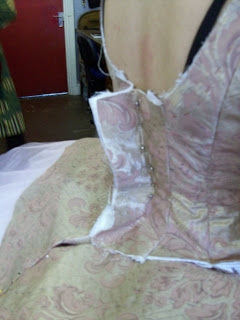Final Evaluation For Self Directed Project I feel I have fulfilled the brief and my Learning Agreement requirements and have achieved the work I set out for myself in a professional way. I have completed a classical ballet tutu which fits the requirements from the client. I feel I have developed my skills in costume construction and have learnt many new skills which will improve my level of making in preparation for my third year of study. . From the first tutorial I was excited about the new challenge I faced and learnt what the group was expected to do. The London fabric sourcing was a beneficial experience as it allowed me to gain knowledge into the location of other fabric shops which will be useful not only in third year but in future work. From the blog tutorial I realized I was not using my blog effectively, therefore from here on I updated it regularly. I have mainly used my blog to reflect and evaluate my work, things I have learnt. Writing these self reflections has enabled me to take a step back from my work and realise what I am learning. . Working in a team on this project has been a good experience in not only preparation for possible future work but also because we were able to support each other during the making process. This will be beneficial for third year when I work on
.
I believe my skills in costume construction have developed and I feel I have progressed as a maker by facing construction challenges and issues, and learning to overcome them. I feel I am beginning to gain some quality control over my work in the sense that I am aware some of the time when something needs to be sorted. This will be highly useful if I can develop this further for and during third year. I felt the standard and fit of my costume was good. I thought the fitting went well and I did not have as many alterations to make as I expected.
.
In my Learning Agreement I stated that one reason for doing this project was to challenge myself which I have certainty done. This costume was challenging to construct and has presented me with many difficulties which I have had to overcome. One example of this was working with new fabrics which can be difficult knowing how to handle them. However this problem will help me in the future because if I come across similar fabrics I will know how to handle them. Although a few aspects have gone wrong within this project I feel I have tried my hardest to keep going and to put things right. For example the pleating of the tutu which I originally sewed wrong, upon assessing the time I had until the next tutorial and the amount of work I had to do in that time I figured I would have time to correct my mistake. I think I judged quite well because I did not fall behind with my work or other aspects of the course. This I believe was a good use of time management and something which I can take on board in future situations.
.
Although I understand this project was self directed and we were meant to be progressing on our own, I felt the group could have gained more if the workshops were not quite so rushed. I also feel at times, aspects of the construction were not explained as fully as they could have been considering this was something none of us had ever done before. I think the timetable for the workshops could have been spaced out more effectively, for example the couple of weeks before the fitting there was not a great deal of practical work to complete whereas in the week proceeding the fitting there was a lot of work to do. One way in which this could have been prevented would have been to have the fitting earlier if that was possible.
.
Now that I have achieved what I set out to do in my Learning Agreement I have now learnt how to make a classical ballet costume, and understand how it is constructed, gained a wider knowledge into the art of ballet, improved and widened my making skills, and worked under a lot of pressure and to tight deadlines at times. If I had more time on this project I would liked to have had time to sew on the braid to the bodice which I will now complete after hand-in.





















.jpg)
.jpg)





